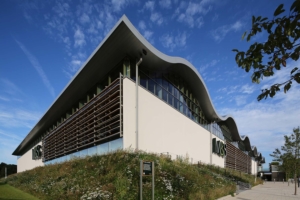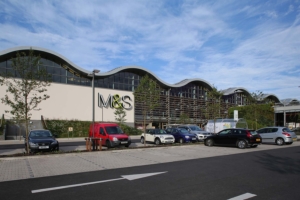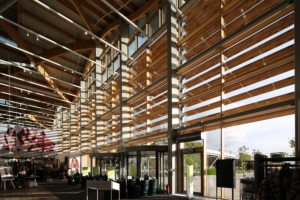 Despite the recession BREEAM continues to grow as specifiers understand the need to embrace sustainability. Senior Architectural Systems have been involved at early design stages in a substantial number of BREEAM projects with high performance facades, windows and doors, all of which have assisted with accreditation.
Despite the recession BREEAM continues to grow as specifiers understand the need to embrace sustainability. Senior Architectural Systems have been involved at early design stages in a substantial number of BREEAM projects with high performance facades, windows and doors, all of which have assisted with accreditation.The Building Research Establishment have stated, “Statistics released at the end of 2012 for BREEAM suggest that developers and owners are continuing to treat sustainability as a priority, despite the tough economic climate,” says Richard Hardy, Managing Director of BRE Global, which develops and manages BREEAM. “They show that 2012 was a record year for BREEAM registrations and certifications. Since 1998 BREEAM has certified more than 16,000 projects, equating to over 250,000 buildings and in excess of 45 million m2 of floor area.
“We believe that one of the reasons for this continuing commitment to making buildings more sustainable,” says Hardy, “is the growing evidence that the greater efficiency and quality associated with sustainability is also helping to make such buildings more commercially successful.”
High performance fenestration systems are a crucial choice in the early design stages of a BREAM accredited project. Not only do the systems specified need to offer exceptional insulation but must also have excellent recycling attributes and offer a long and low maintenance life. Involvement of a facade specialist at the very early design stages will give the specifier choices as to which system will best suit the project, this will include the adoption of solar shading, natural ventilation systems, renewable technologies, et al. Systems companies such as Senior’s work closely with other leading specialist companies who provide these technologies and together form a strategic alliance which can offer the specifier the most efficient solution for the project, saving both time and expense in the longer term.
 The prime choices of fenestration material for BREEAM projects include aluminium and timber, both well respected, highly recyclable materials in their own right. Combining the best attributes of both offers a ‘composite product’, known as a ‘Hybrid’ system. Senior’s Hybrid products are designed to combine the long life and low maintenance of aluminium on the outside with the high insulation, environmentally focused benefits, of 100% PEFC accredited timber to the inside. All materials used in the Hybrid system’s construction are fully recyclable.
The prime choices of fenestration material for BREEAM projects include aluminium and timber, both well respected, highly recyclable materials in their own right. Combining the best attributes of both offers a ‘composite product’, known as a ‘Hybrid’ system. Senior’s Hybrid products are designed to combine the long life and low maintenance of aluminium on the outside with the high insulation, environmentally focused benefits, of 100% PEFC accredited timber to the inside. All materials used in the Hybrid system’s construction are fully recyclable.Senior’s Hybrid Series 3 high performance Curtain Walling was chosen by M&S for its new flagship store at Cheshire Oaks. The timber aluminium composite system perfectly complements the ‘Wave Style Roof’ built from over 1400m3 of 100% FSC-certified, curved Glulam timber beams. The new store may be the most high profile, sustainable, retail project ever undertaken to date which achieves a ‘BREEAM Excellent’ rating.
The new store, designed by Aukett Fitzroy Robinson (AFR), sets new standards for sustainability in the UK retail sector and is the largest store for the retail giant outside London, covering a sales area of 18,100 m2. One of the reasons for the store’s low environmental impact is its extensive use of renewable materials. Senior’s Hybrid Curtain Wall reflects these design principles perfectly with its 100% recyclable timber and aluminium profiles.
The innovative and sustainable design approach adopted by AFR is in line with Marks & Spencer’s ‘Plan A’; a policy which aims to make them the most sustainable retailer in the world. Together with rainwater harvesting, LED low energy lighting, and roof insulation derived from recycled bottle glass, to name but a few, the store is one of the first to harness natural light. By using a large area of Hybrid Curtain Walling, with Cedar Wood Brise Soleil and north-facing Rooflights, the new store maximises the best use of indirect natural light. Not normally utilised in a retail environment, the use of natural light offers further energy savings which, in turn, helps with the attainment of further BREEAM points.
Property developers and owners are beginning to realise that BREEAM accredited buildings can achieve higher income revenue from leaseholders. Buildings not only save resources in running costs, but portray businesses as caring for the environment.
 As well as environmental benefits, a BREEAM assessed building offers reduced energy and running costs, higher potential income from rent, and improved staff productivity due to a more comfortable, productive working environment. There are also publicity benefits, including making buildings more lettable or saleable, demonstrating environmental commitments to customers and an ultimately an improved image for the building.
As well as environmental benefits, a BREEAM assessed building offers reduced energy and running costs, higher potential income from rent, and improved staff productivity due to a more comfortable, productive working environment. There are also publicity benefits, including making buildings more lettable or saleable, demonstrating environmental commitments to customers and an ultimately an improved image for the building.Natural ventilation solutions now replace costly ‘air conditioning’ and use optimally placed window vents coupled with window actuators and sophisticated computerised controls. Senior Architectural Systems have developed strategic alliances with companies providing these services, which allows building design to be optimised at an early stage. Window automation can include links with fire protection systems to offer smoke control protection, ultimately leading to safer buildings, a legal pre-requisite for all building owners today. Window automation can also include such strategies such as ‘night purge’ ventilation which offers a complete air change when the building or office complex is unoccupied.
BREEAM accreditation has now been adopted by many countries in Europe and also further afield, thereby confirming the relevance of BREEAM certification. More recently BREEAM accreditation has been applied to existing buildings and is known as ‘BREEAM In-Use’. The scheme helps building managers reduce the running costs and improve the environmental performance of existing buildings. Using a assessment methodology and an independent certification process. Parts 1 and 2 of the BREEAM In-Use Certification Scheme are relevant to all non-domestic: commercial, industrial, retail and institutional buildings. Part 3 of the BREEAM In-Use certification scheme is currently restricted to offices.
Senior’s understand the specifiers needs and can help in the attainment of a BREEAM rating in either a new project at early design stages, or an existing building where window replacement is required. Senior’s experienced Technical Field Managers are available across the UK to advise.

Comments are closed.